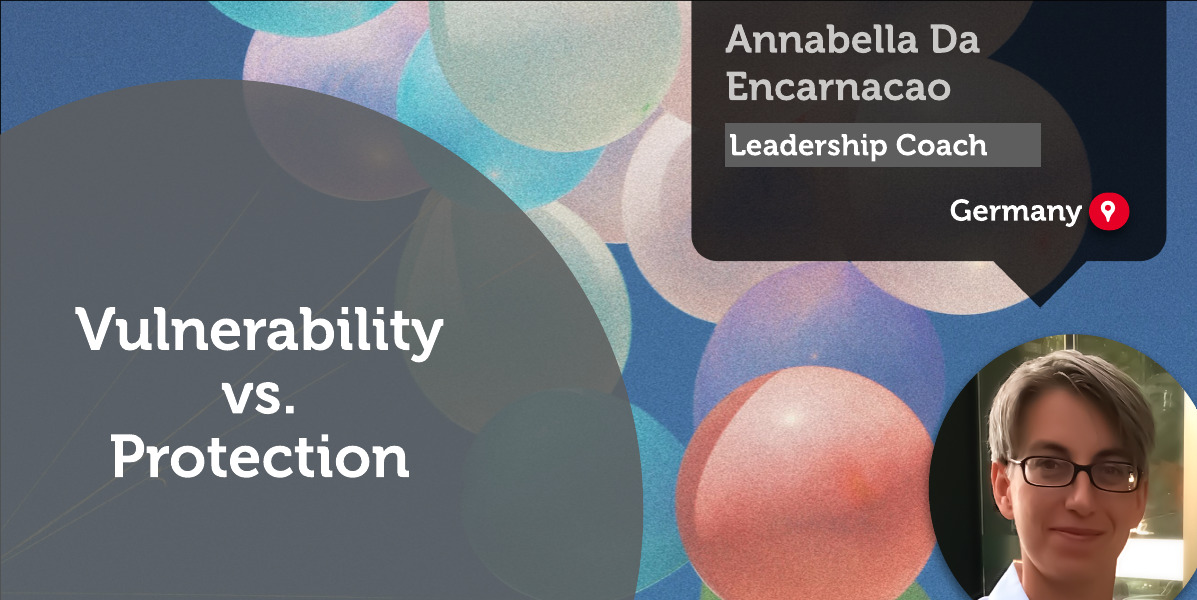A Coaching Power Tool By Annabella Da Encarnacao, Leadership Coach, GERMANY

The Difference Between Vulnerability vs. Protection
Oxford English Dictionary
Vulnerability:
/vʌln(ə)rəˈbɪlɪti/
noun
The quality or state of being exposed to the possibility of being attacked or harmed, either physically or emotionally.
That is not an attractive and joyful definition. A state of being attacked or harmed is not a state human beings would consciously like to be experiencing.
In IT, vulnerabilities are flaws in a computer system that weaken the overall security of the device/system. Vulnerabilities can be weaknesses in either the hardware itself or the software that runs on the hardware – Wikipedia.
We associate the possibility of being attacked or harmed with flaws, and weaknesses. Our society is negatively biased towards vulnerability through its own association of ideas.
Protection as a Shield
Vulnerability is at the core of fear, anxiety, shame and difficult emotions – Brené Brown.
What do people do when facing a potential attack on their flaws and weaknesses? They protect themselves.
In IT, you protect against vulnerabilities with anti-virus software, regular patches to fix weaknesses, stronger passwords, a firewall, etc…
For we humans, we have a very similar process.
We make ourselves inaccessible, we build a mental wall so that no one can see who we really are, our core. We make our core sacred and secret. Because it would hurt too much if someone would access it and harm it.
Problem is, that we are humans, not computers. While protecting our data cannot harm us, protecting our core can harm us even more.
Understanding Vulnerability vs. Protection
As an inexperienced leader, pressure to look good is high. There is downwards management, upwards management, peer influencing and of course, very often no or poor education on what leadership is.
The need to protect oneself from potential negative judgment is immense and when we are unsure of ourselves we retreat to familiar behaviors and styles.
In our working culture, this familiar style still is corporate management with hierarchical power as the default projection of leadership and management style. The stereotypical image of a tough, strong, authoritative leader that nothing and no one can harm.
The danger is, in order to protect ourselves from vulnerability, we protect ourselves from our identity, we numb ourselves entirely.
We cannot compartmentalize and selectively numb emotions. By trying not to feel difficult feelings, we numb the positive feelings too. We numb joy, creativity, love, and belonging.
In doing so, we pretend to be someone else, someone that fits with who we think looks perfect from the outside – this strong and tough character. Slowly losing who we are at our core and with it our human connection. We isolate.
Connection with others is the outcome of authenticity. It is also what gives us purpose and meaning, therefore: by faking to be someone else, we lose connection to others and to ourselves.
We then struggle with our own feeling of value. The further away we move from who we really are, the more we feel we are not good enough, we‘re not doing enough. We feel like an imposter. We crash.
Vulnerability vs. Protection: Expanding Our Perception
Vulnerability is the birth place of joy, love, belonging, creativity, faith – Brené Brown.
- What would happen if we allow ourselves to be seen instead?
- Have the courage to be imperfect and show who we really are?
In difficult situations, by deciding to stay uncomfortable, to lean into the hard conversations, and to stay brave, we actually embrace vulnerability.
What we considered threats and unwelcome changes become growth opportunities and new learnings.
By letting go of who we think we should be in order to be who we really are, we work on our human connection, to ourselves and to others.
In the workplace, we feel more comfortable around a leader who is authentic and vulnerable because we are sensitive to signs of trustworthiness, we will see them as human beings and feel closer to them. As a consequence, employees will demonstrate and experience a more positive behavior and mindset as well as greater feelings of trust and loyalty.
In order to embrace our vulnerability and be authentic, we must first learn to love and accept our whole selves. We need first to understand ourselves, and our story, build self-awareness and envision our future selves. By leading ourselves in this direction, building new positive habits, and exposing ourselves, we connect, we understand others, and we build compassion and kindness as well as stronger relationships.
When we accept vulnerability, we also gain confidence and belief in ourselves to be able to handle challenging situations, we become more resilient.
We find our own purpose. And we can lead more effectively.
What makes us vulnerable is what makes us human. Embracing our vulnerability is our best strength as a human and leaders.
References
Bill George - Discover your True North
Herminia Ibarra - The Authenticity Paradox, HBR
Emma Seppala - What bosses gain by being vulnerable, HBR
Dan Owolabi - Authentic Leadership
Brené Brown - TEDxHouston - The power of vulnerability